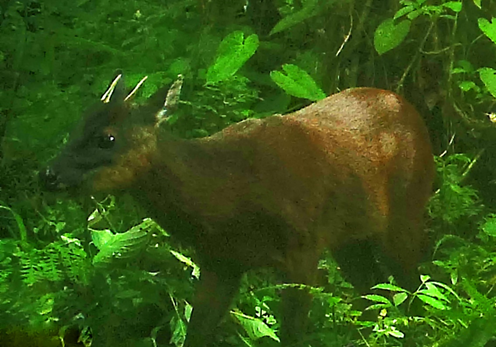
Published
Elevation as an occupancy determinant of the little red brocket deer (Mazama rufina) in the Central Andes of Colombia
Elevación como un determinante de la ocupación del venado soche (Mazama rufina) en los Andes centrales de Colombia
DOI:
https://doi.org/10.15446/caldasia.v43n2.85449Keywords:
camera trap, Andean mountains, Cervidae, detection probability (en)Trampa cámara, Cervidae, montañas andinas, probabilidad de detección (es)
Downloads
Additional Files
We assessed the influence of terrain variables on the occupancy of the little red brocket deer (Mazama rufina) in the Central Andes of Colombia. Occupancy increased with elevation up to 3000, where it starts decreasing. This information is crucial to predict the potential effects of climate change on M. rufina and other mountain species.
Evaluamos la influencia de variables del terreno sobre la ocupación del venado soche en los Andes centrales de Colombia. La ocupación aumenta con la elevación hasta los 3000 m y por encima de este valor decrece. Esta información es crucial para predecir los posibles efectos del cambio climático sobre M. rufina y otras especies de montaña.
References
Akaike H. 1973. Information theory and an extension of the maximum likelihood principle. In: Petrov BN, Csaki F, editors. 2nd International Symposium on Information Theory. Budapest: Akadémiai Kiadó. p. 267–281.
Elsen PR, Tingley MW. 2015. Global mountain topography and the fate of mountain species under climate change. Nat. Clim. Change 5(8):772-776. doi: https://doi.org/10.1038/nclimate2656
Fegraus EH, Lin K, Ahumada JA, Baru C, Chandra S, Youn C. 2011. Data acquisition and management software for camera trap data: A case study from the TEAM Network. Ecol. Inform. 6(6):345–353. doi: https://doi.org/10.1016/j.ecoinf.2011.06.003
Fiske I, Chandler R. 2011. unmarked: An R Package for fitting hierarchical models of wildlife occurrence and abundance. J. Stat. Softw. 43(10):1–23. doi: https://doi.org/10.18637/jss.v043.i10
Grotta-Neto F, Peres PHF, Piovezan U, Passos FC, Duarte JMB. 2019. Influential factors on gray brocket deer (Mazama gouazoubira) activity and movement in the Pantanal, Brazil. J. Mammal 100(2):454–463. doi: https//doi.org/10.1093/jmammal/gyz056
Jankowski JE, Londoño GA, Robinson SK, Chappell MA. 2013. Exploring the role of physiology and biotic interactions in determining elevational ranges of tropical animals. Ecography 36(1):1-12. doi: https://doi.org/10.1111/j.1600-0587.2012.07785.x
Lizcano DJ, Alvarez SJ. 2016. Mazama rufina. The IUCN Red List of Threatened Species 2016: e.T12914A22165586. [Last accessed: 28 Feb 2020]. doi: https://doi.org/10.2305/IUCN.UK.2016-2.RLTS.T12914A22165586.en
Lizcano DJ, Alvarez SJ, Delgado-V C. 2010. Dwarft red brocket Mazama rufina (Pucheran 1951). In: Duarte, JMB, González, S, editors. Neotropical Cervidology: Biology and Medicine of Latin American Deer. Jaboticabal: Funep. p. 177–180.
MacKenzie DI, Nichols JD, Royle JA, Pollock KH, Bayley LL, Hines JE. 2006. Occupancy Estimation and Modeling: Inferring Patterns and Dynamics of Species Occurrence. Burlington: Academic Press.
Meek PD, Ballard G, Claridge A, Kays R, Moseby K, O’Brien T, O’Connell A, Sanderson J, Swann DE, Tobler M, Townsend S. 2014. Recommended guiding principles for reporting on camera trapping research. Biodivers. Conserv. 23:2321–2343. doi: https://doi.org/10.1007/s10531-014-0712-8
Mysterud A. 1999. Seasonal migration pattern and home range of roe deer (Capreolus capreolus) in an altitudinal gradient in southern Norway. J. Zool. 247(4):479–486. doi: https://doi.org/10.1111/j.1469-7998.1999.tb01011.x
TEAM Network. 2011. Terrestrial vertebrate protocol implementation manual, v. 3.1. Centre for applied biodiversity science. Arlington: Tropical Ecology, Assessment and Monitoring Network, Center for Applied Biodiversity Science, Conservation International.
Wyckoff TB, Sawyer H, Albeke SE, Garman SL, Kauffman MJ. 2018. Evaluating the influence of energy and residential development on the migratory behavior of mule deer. Ecosphere 9(2):e02113. doi: https://doi.org/10.1002/ecs2.2113
How to Cite
APA
ACM
ACS
ABNT
Chicago
Harvard
IEEE
MLA
Turabian
Vancouver
Download Citation
CrossRef Cited-by
1. Juan Camilo Cepeda-Duque, Eduven Arango-Correa, Christian Frimodt-Møller, Diego J. Lizcano. (2024). Howling shadows: First report of domestic dog attacks on globally threatened mountain tapirs in high Andean cloud forests of Colombia. Neotropical Biology and Conservation, 19(1), p.25. https://doi.org/10.3897/neotropical.19.e117437.
Dimensions
PlumX
Article abstract page views
Downloads
License
Copyright (c) 2020 Caldasia

This work is licensed under a Creative Commons Attribution 4.0 International License.
Authors who publish with this journal agree to the following terms:
- Authors retain copyright and grant the journal right of first publication with the work simultaneously licensed under a Creative Commons Attribution License that allows others to share the work with an acknowledgement of the work's authorship and initial publication in this journal.
- Authors are able to enter into separate, additional contractual arrangements for the non-exclusive distribution of the journal's published version of the work (e.g., post it to an institutional repository or publish it in a book), with an acknowledgement of its initial publication in this journal.
- Authors are permitted and encouraged to post their work online (e.g., in institutional repositories or on their website) prior to and during the submission process, as it can lead to productive exchanges, as well as earlier and greater citation of published work (See The Effect of Open Access).




























